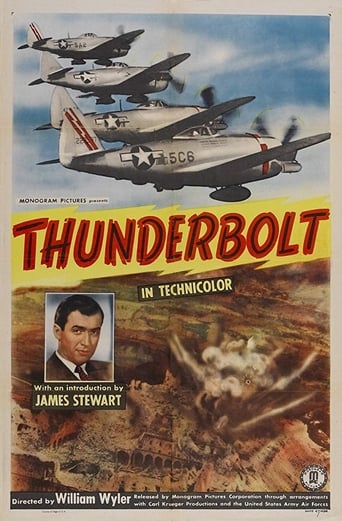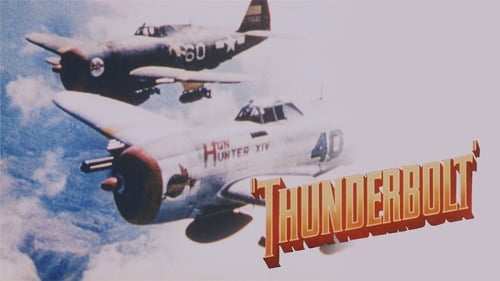


A documentary series on the operations of the 57th Fighter Group in 1944. Stationed in Corsica, their missions largely consisted of low-level attacks on the Italian mainland, far behind the frontline. Their targets were German supplies and the infrastructure carrying it. This was part of Operation Strangle, the idea of which was to weaken the German front-line forces through depriving them of supplies, thus helping the Allied offensive through Italy. The 57th Fighter Group flew one of the greatest fighter-bombers of the war, the iconic Republic P-47 Thunderbolt.Superb documentary, directed by famed Hollywood director William Wyler (with John Sturges as co-director). Wyler's previous contribution to the Allied war effort was the equally-superb "The Memphis Belle: A Story of a Flying Fortress". Through clever placement of cameras on the Thunderbolts - behind the pilot looking forward, in the instrument panel looking at the pilot, in the wings, under the wings, in the undercarriage bay - we get a unique and illuminating perspective of the missions the 57th Fighter Group flew. Captures well the essence of their operations, and the dangers.The human side is well told - we see the pilots during their down time, learn something about them and understand how they lived and the rigours they went through.On that note, the movie is quite unique for a wartime documentary in that it shows the horrors of war. We see Allied casualties, including the charred remains of a P-47 pilot whose plane crashed.Wyler himself was one of those casualties, suffering total deafness due to filming much of the action from a noisy B-25 bomber. Unfortunately, WW2 ended before Wyler managed to have the movie released. It ended up only being released in 1947.
... View More"Thunderbolt" is a 42-minute documentary that was made shortly after World War II. There are some big names associated with this project such as James Stewart, Lloyd Bridges, William Wyler or John Sturges. It is about airplanes during the days of war and how American pilots were good enough to make a lasting impact thanks to ability and technology. Sometimes, it also gets concrete in terms of particular strikes during these days of war. I myself am more interested in the political aspects of these dark days than in technical factors. Also, this film got a tad too patriotic occasionally for my taste. It is not a bad film by any means and can be informative if you have an interest in the subject, but it's just such a particular area that most probably won't. All in all, I was not impressed watching this.
... View MoreThis film is introduced by Jimmy Stewart and part of the narration is provided by Lloyd Bridges. It shows the duties of a fighter group-- P-47 pilots whose job it is to blow the crap out of railroads, roads and targets of opportunity in order to choke off supplies to German troops in Southern Italy."Thunderbolt" was made in 1944 or 1945 (the film says 1944 and IMDb says '45) but it wasn't released until 1947. You can actually tell it wasn't released during the war because some aspects of this documentary probably wouldn't have done a lot to stir up the folks at home with patriotic zeal. This is because the documentary shows a few things that might have discouraged the audiences--such as one of the American planes crashing and killing the pilot. Also, there were quite a few VERY grisly corpses--things that I doubt that they would have wanted to show civilians. For the most part, films shown to the public were pretty sanitized...and this one wasn't. Now this is NOT a complaint- -in fact it makes this a much better and more realistic film. My only complaint about the film is the terrible quality of all the color footage. It's very degraded and muddy and could use conservation.
... View MoreOften times film making from the war slips into propaganda and flag waving. This film instead shows the cold hard truth of a fighter group working out of Corsica in 1944. The personal, humanized glimpses of real men instead of lantern jawed actors as they go on about their days, living their daily lives worrying about who won't come back. The shooting style is from on board cameras from several points on the planes and shows so many real mission realities from a normal fighter sweep over Italy including coldly shooting up innocent farmhouses in search of one that's not so innocent and plowing any thing that moves in the daylight.At some point as you watch this you go through so many emotions from the shock of realizing just how young these pilots are to being mystified about how they can be so cold as they light up the Italian country side to a sad understanding as director William Wyler shows you what would never be shown in a Frank Capra's "Why We Fight" movies, the charred body of a Jug pilot being pulled from the burning wreckage of his fighter with a hook. The end scene of the pilots and crews falling over drunk makes complete sense.This film is much more poignant than Wyler's later film "Memphis Belle" which while good shows the touch of war time censors. Released in 1945, after the war in Europe was over, "Thunderbolt" drives home the very humancosts of war.
... View More